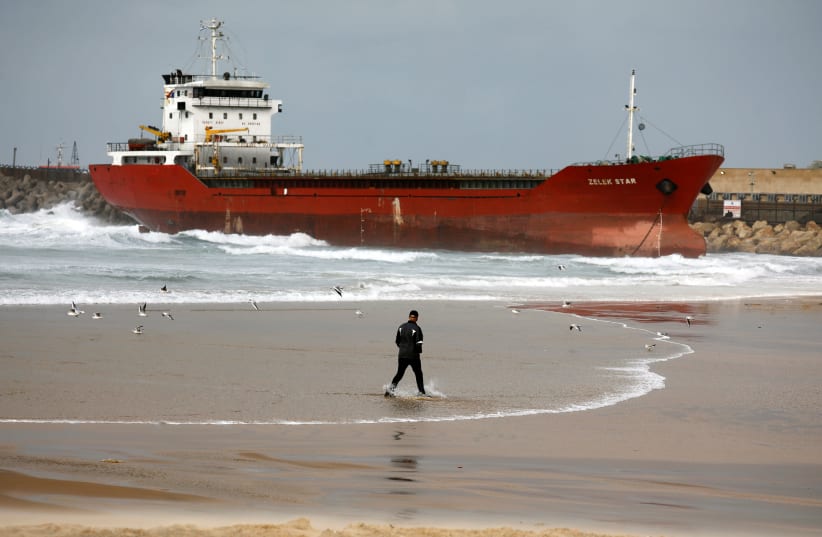Iran is the main suspect behind the attack overnight Thursday on an Israeli-owned cargo vessel that was damaged by a mysterious explosion in the Gulf of Oman, Defense Minister Benny Gantz said on Saturday.
“We will need to keep investigating, but we can say for sure that Iran is attempting to damage Israeli infrastructure and to hurt Israeli citizens,” Gantz told KAN. He noted that the ship’s proximity to Iran during the incident has strengthened the suspicions against Tehran.
שר הביטחון גנץ בתגובה ראשונה לפיגוע בספינה באולפן #הכול_פוליטי: ההערכה היא שהאיראנים עומדים מאחורי הפעולה@asaf_lib pic.twitter.com/SRZrTJVhaL
— כאן חדשות (@kann_news) February 27, 2021
The ship – Helios Ray – usually used as a vehicle carrier, was sailing to Singapore from Saudi Arabia when the explosion occurred. It was then diverted to a port in Dubai to assess the damage.
The ship’s company was reportedly in good condition and there were no known injuries. It continued under its own power to Dubai.
Several assessments have pointed to possible causes for the explosion. According to early estimations made by the United Kingdom Marine Trade Operations (UKMTO), the explosion was most likely the result of a maritime mine being triggered.
However, a US defense official later told Reuters that the ship was hit by a blast above the water line that ripped holes in both sides of its hull. If correct, this would mean that it is highly unlikely that the damage was caused by an anti-ship mine.
UKMTO noted that initially, it was not ruling out any option and had issued a warning to nearby vessels, advising them to stay away from the area until the incident is clarified.
Officials from the security firm Dryad that was securing the area have also said that they are examining the possibility that the Iranian military was involved.
“Whilst details regarding the incident remain unclear, it remains a realistic possibility that the event was the result of asymmetric activity by Iranian military,” Dryad said in a report.
On Sunday, an analysis in the Iranian-regime controlled Kayhan daily, whose editor-in-chief is appointed by Iranian Supreme Leader Ali Khamenei, referred to the attack on the Israeli vessel as a response to strikes on Iranian and pro-Iranian forces in Syria and Iraq.
The analysis stated that there is "no trace" of the identity of the attackers and claimed that the vessel was flown under the flag of another country. The paper additionally claimed that the ship was a military vessel spying in the Persian Gulf and not a commercial vessel.
The analysis concluded that the ship was "probably ambushed by one of the branches of the axis of resistance," but did not go as far as explicitly stating that Iran or one of its proxies was responsible for the incident.
In an interview to Ynet, Rami Ongar, the Israeli businessman who owns Helios Ray, said he did not believe that the explosion was the result of an intentional attack, but he noted that the ship has holes in it, which may indicate damage caused by missiles.
Ongar said it was possible that if the explosion had been the result of an Iranian attack, it might have been a signal to the Biden administration.
"שני חורים בקוטר של כמטר וחצי": תיעוד הנזק בספינת איש העסקים הישראלי בפיצוץ במפרץ עומאן, החשוד כנקמה איראנית@MoavVardi https://t.co/aKh3iAiatW
— כאן חדשות (@kann_news) February 26, 2021
On Saturday, N12 reported that a delegation of representatives from Israel’s defense industries that was meant to travel to an international exhibition in Abu Dhabi did not receive approval to travel due to Iranian threats in the region. This differed from an earlier reason given for the Israeli no-show due to health concerns, and fears that the delegation might import coronavirus mutations upon their return home.
The US Navy’s Bahrain-based Fifth Fleet said it was aware of the incident and was monitoring the situation.
Tensions have risen in the Gulf region since the United States reimposed sanctions on Iran in 2018 after then-president Donald Trump withdrew America from the Islamic Republic’s 2015 nuclear deal with major powers.
Washington has blamed Tehran for a number of attacks on shipping in strategic Gulf waters, including on four vessels, including two Saudi oil tankers, in May 2019. Iran distanced itself from those attacks.
In early January, Iran’s Revolutionary Guard Corps seized a South Korean-flagged tanker in Gulf waters and detained its crew amid tensions between Tehran and US ally Seoul over Iranian funds frozen in South Korean banks due to the US sanctions.
In 2018, 21 million barrels per day of oil flowed through the Gulf’s Strait of Hormuz, equivalent to about 21% of global petroleum liquids demand at the time, according to the US Energy Information Administration.
